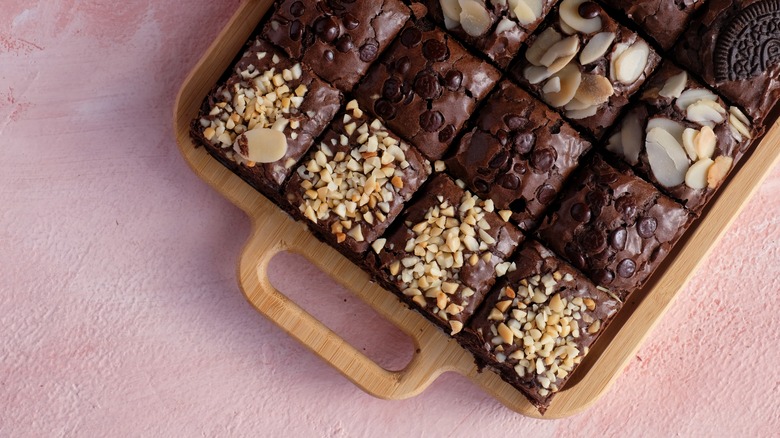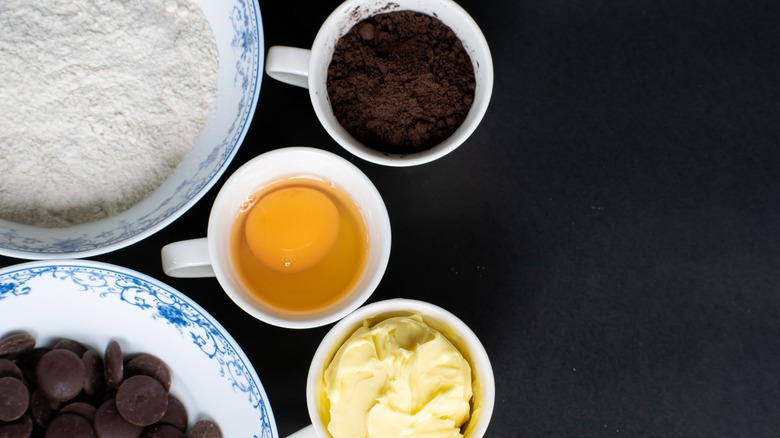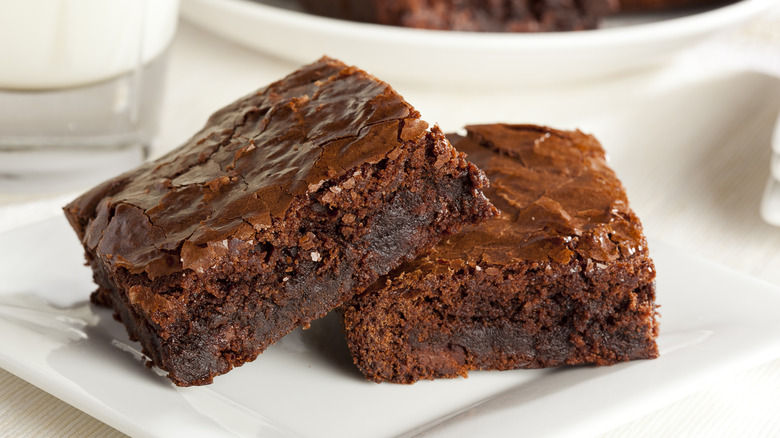The Reason You Should Beat Eggs And Sugar Together First When Making Brownies
Apple pie is considered the all-American dessert, but that might be selling the brownie short. The brownie feels just as quintessentially American as apple pie, and that's because they are. How the brownie came to be is sometimes debated, but a Chicago socialite and the pastry chefs at a prominent hotel are most often credited with creating the sweet treat.
According to Forbes, Bertha Palmer asked chefs at the Palmer House Hotel to create a dessert that was easy to transport. They came up with the basic idea for brownies in 1893. More than 10 years later, though, several recipes for sweets called brownies would appear in cookbooks. According to Cupcake Project, an early brownie recipe appeared in an 1899 recipe book, but it didn't look like any brownie we know today. The recipe was for a molasses-based treat called a brownie, but made without any chocolate. The source notes that the first chocolate brownie recipe appeared in a cookbook published in 1905.
Regardless of how brownies came to be or who is credited with their creation, most people agree that the iconic treat is the perfect way to sweeten up any holiday, party, or, frankly, a random Wednesday. If you are planning to make your own brownies, we have a tip to ensure that your homemade creation is just as glossy, airy, and crackled as any brownie you'd get from a bakery.
Beating your eggs and sugar first creates glossy brownies
Brownies made by professionals and brownies made at home almost always look slightly different. Both treats are delicious, but chef-made brownies have something a little special about them. Cookbook author and food stylist Jerrelle Guy might have given away the secret: In an article for The Kitchn, Guy suggests the secret to a "glossy" and lifted brownie — like the ones you see in bakeries and restaurants — is to beat the eggs and the sugar together for 10 minutes before adding additional ingredients. According to Guy, the process will introduce just the right amount of air into the batter. This aeration will lead to a finished product that is shiny, nicely risen, and perfectly crackled on top.
Mixing fat and sugar together before adding additional ingredients is a common technique in baking. Many cookies and cake recipes call for bakers to cream together butter and sugar before adding other ingredients. The goal, just like with Guy's brownie tip, is to add air to a cake batter or cookie dough. According to Taste of Home, the creaming process is complete when the mixture is pale and fluffy, which can take anywhere from 2 to 7 minutes.
Additional tips for adding air to a brownie batter
While the process of beating eggs and sugar together before incorporating other ingredients into brownie batter is simple enough, there are a couple of more rules you should follow for a successful baking experience. King Arthur Baking suggests using room-temperature eggs when using this mixing method. While the technique — which King Arthur calls the "ribbon stage," since the resulting mixture "should fall in thick ribbons" — will still work with cold eggs, eggs that have come up to room temperature trap more air and will result in a fluffier final product.
Once you've perfected this particular technique, you don't want to waste the work you've just done. Whipping air into batter is a delicate process, and can be easily undone. After achieving the perfect mixture, you can then add the rest of the recipe's ingredients, but make sure to do it slowly and carefully. If you dump everything into the mixing bowl and turn it on high, you risk deflating the mixture. Incorporating additional dry ingredients slowly will ensure the air remains in the batter. The result will be the perfect, fluffy homemade brownie with the beloved baked good's signature glossy, crackled top.
As an added step you can mix all of your dry ingredients together before incorporating them into your wet mixture. According to Stress Baking, mixing your wet and dry ingredients separately and then combining them will result in an extra fluffy baked good.


